
- Index
- Brand
- Closure
- Department
- Material
- 14k Gold (13)
- 14k Gold Filled (9)
- 18k Gold (14)
- 18k Solid Gold (8)
- Base Metal (6)
- Brass (14)
- Chrome (10)
- Coin Silver (9)
- Enamel (49)
- Gold (65)
- Gold Filled (34)
- Gold Plated (86)
- Metal (14)
- Platinum (6)
- Silver (145)
- Solid Gold (245)
- Solid Silver (116)
- Stainless Steel (11)
- Sterling Silver (64)
- Yellow Gold (26)
- ... (3753)
- Type
- Antique Watch Chain (3)
- Bracelet (5)
- Chain (41)
- Deck Watch (3)
- Fob (19)
- Hand-winding (25)
- Mechanical (3)
- Montre De Poche (3)
- Montre à Gousset (14)
- Movement (18)
- Necklace (8)
- Necklace / Choker (8)
- Pendant (6)
- Pendant / Locket (14)
- Pocket Watch (1817)
- Pocket Watch Case (3)
- Pocket Watch Chain (10)
- Pocket Watches (11)
- Watch Chain (27)
- Wristwatch (50)
- ... (2609)
- Vintage
MUSEUM antique Berthoud a Paris 18k gold&silver Verge Fusee mens ring watch, 1800

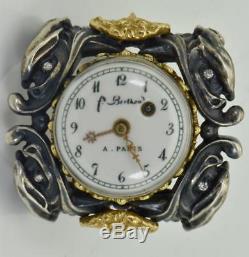
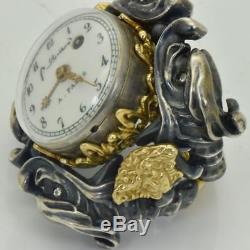
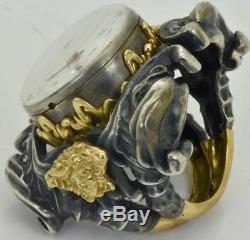
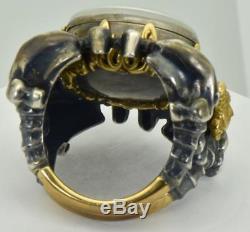
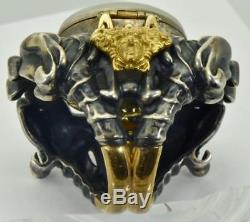
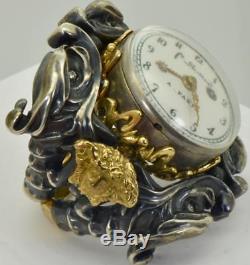
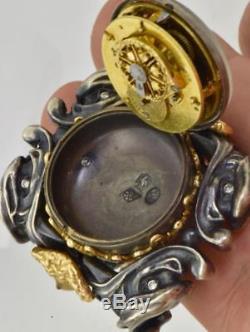
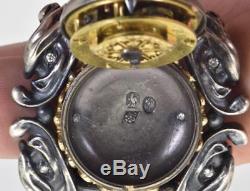
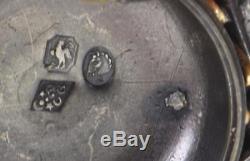
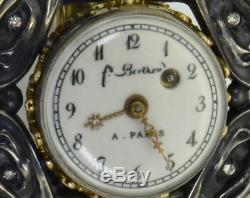
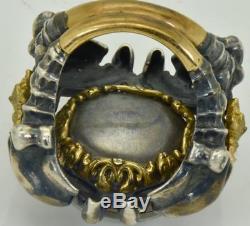


MUSEUM antique Berthoud a Paris 18k gold&silver Verge Fusee mens ring watch, 1800. This is the rarest and the most impressive antique jewelry I have ever seen!
A mesmerizing piece of art! This Baroque large mens ring is made of solid 18k gold and silver, decorated with diamonds. The ring depicting 4 sea monsters and 2 solid gold Meduza Gorgon heads. Solid gold crown and solid gold ring band. It has 20mm verge fusee movement. Signed with the old French hallmarks. The ring is large man size-12.5 US ; 68 EU ; Y UK. The front of the ring measue 43x40mm. NOTE:PLEASE OBSERVE CAREFULLY THE PHOTOS!IT IS A SIGNIFICANT PART OF THE DESCRIPTION. Every potencial defect which is shown in the photos, but not mention in the description, will be considered for described.
All the photos shoot by professional Nikon 105 Macro lens under 40x diopter magnification, so you can explore even the smallest detail like under microscope! Ferdinand Berthoud 18 March 1727, Plancemont-sur-Couvet, Val-de-Travers, Canton of.
Was a French watchmaker and scientist. He was awarded the title of Master Watchmaker in. He occupied the position of Horologist-Mechanic by appointment to the King. And the Navy and left behind him an exceptionally broad body of work, notably in the field of marine chronometers. He succeeded the pioneering work of.
At the king's insistence he travelled to England to view the chronometers of. Together with his great rival.Berthoud contributed to the development of the chronometer. He was made a member of the.
Fellow of the Royal Society. Among other works he wrote Essai sur l'horlogerie in 1763. On April 16, 1745 at the age of 18, a move that enabled him to perfect his knowledge of the watchmaking-clockmaking profession. He is generally considered to have entered the workshop of.
Ferdinand Berthoud rapidly acquired a reputation for technical competence and achieved recognition for his innovations in his field. From 1755 onwards, he was entrusted with writing several reference articles on horology for the Methodical Encyclopaedia published between 1751 and 1772 under the supervision of Diderot and dAlembert. Ferdinand Berthoud published his first specialised book in 1759, entitled Lart de conduire et de régler les pendules et les montres, à lusage de ceux qui nont aucune connaissance dhorlogerie. (The art of operating and adjusting clocks and watches for those who have no horological knowledge).
This was a popular scientific work that proved a great success and was translated into several languages and then repeatedly re-edited during the 18th and 19th centuries. On December 13, 1760, Ferdinand Berthoud submitted to the. French Royal Academy of Science. A Mémoire sur les principes de construction dune Horloge de Marine (Dissertation on the construction principles of a marine chronometer), the famous Marine Chronometer No. 1, whose construction was completed at the start of 1761.
He made marine clocks to calculate longitude at sea. In 1764, by order of the King, the Academy charged two of its members. And Abbot Chappe dAuteroche with putting the Marine Chronometer No. 3 by Ferdinand Berthoud to trial at sea. They set off from Brest aboard the corvette LHirondelle on October 7 that year, accompanied by Ferdinand Berthoud.The mission report, read by Abbot Chappe dAuteroche to the Academy on November 14, was never published, an exceptional occurrence. In his Traité des horloges marines (Treatise on marine chronometers), Berthoud insinuates that this omission was due to Duhamel du Monceau whose nephew, Fougeroux de Grandlieu, having served as lieutenant during this expedition, died several days after the ships return.
Ferdinand Berthoud was appointed Horloger du roi (Horologist-Mechanic by appointment to the King and the Navy) in 1770. He was also named a member of the Institute right from the time of its creation in 1795. Berthoud had meanwhile become a member of the.
He is regarded as one of the inventors of the marine chronometer that served to determine longitude at sea necessary to navigation. His nephew Louis Berthoud, also distinguished himself as a horologist. Ferdinand Berthoud married Henriette Chatry de La Fosse, and later Marie Adélaïde Dumoustier. He died in 1807 at his home in Groslay near. He had married twice, firstly Mademoiselle Chati of Cean, and then Mademoiselle Dumoustier of Saint Quentin, but had no children.His business passed to his nephew, Louis Berthoud (17591813). Obliged to work as a companion-horologist with masters of the Parisian corporation, having failed to serve his apprenticeship under one of them, the young Berthoud managed to overcome this hurdle by drawing attention due to his application in perfecting the art of watchmaking. He seized the possibility of making his research known at the Royal Academy of Science by submitting a sealed document describing a new construction. The approval, granted by academy members on April 26, 1752, of an equation clock that was deemed highly ingenious, marked the start of his career as a researcher, while also enabling him to lay claim to official integration into the horological community. On December 4, 1753, the King of France ordered that he should be granted the title of master.
Authorising him to open a workshop on the Rue de Harlay, near the Place Dauphine. In 1754, the master horologist once again submitted his inventions to the Academy. One was his first marine chronometer project. The others, examined and approved by academy members, were also equation systems: a concentric seconds equation marking the months and days of the month, leap years, and running for 13 months without requiring rewinding; a seconds and equation watch marking the month and days. Before even being named a Master Watchmaker, Ferdinand Berthoud revealed the meaning he wished to give to his career: devoting himself to research and passing on his knowledge through publications and teaching.This two-fold commitment enabled him to swiftly establish himself in the scientific circles of his era. Several articles of the Encyclopaedia supervised by.
Were entrusted to him, particularly the Equation article. In 1759, he published a popular work that would prove a success: LArt de conduire et de régler les pendules et les montres. A lusage de ceux qui nont aucune connaissance dhorlogerie (The art of operating and adjusting clocks and watches for those who have no horological knowledge). In 1763, his voluminous treatise, LEssai sur lhorlogerie ; dans lequel on traite de cet Art relativement à lusage civil, à lAstronomie et à la Navigation (Essay on Horology, dealing with this Art relating to civilian use, astronomy and navigation).
The year 1763 marked a turning point in Berthouds career, which was now closely linked with the progress of maritime navigation. The Academy of Science was once again both a witness and a support in this realm: the horologist had two sealed documents describing Marine Chronometer no.1 delivered to it in 1760 and 1761. Convinced by the watchmakers competence, the academy members persuaded the French Navy Ministry to send Berthoud to examine Harrisons marine chronometer. This turned out to be an opportunity for him to be appreciated by his peers and appointed as a foreign associate of the Royal Society on February 17, 1764. On August 29 that same year, Ferdinand Berthoud once again submitted a document relating to the construction of a marine clock. It was to be the last: Berthoud was by then certain to have found the path of his research and to have the possibility of requesting official backing.
The cadence for his activities was set by projects relating to detailed requests. He proposed the construction of two marine clocks on May 7, 1766: these were Nos 6 and 8 exhibited at the. French Arts & Crafts Museum. After successful experimentation with these clocks, Ferdinand Berthoud was awarded the title Brevet dhorloger Méchanicien du Roi et de la Marine ayant linspection de la construction des Horloges marines (warrant of Horologist-Mechanic by appointment to the King and the Navy responsible for the construction of marine clocks), specifically created for him on April 1, 1770. From that point onward, he set aside the management of his workshop-boutique to dedicate himself to research, stating in 1792: it was above all from 1770 onwards that I devoted myself wholeheartedly to this aspect and in some ways departed from my public work.
A tenacious experimenter, a clever and daring builder and an inventor keen to share his knowledge, Ferdinand Berthoud not only played a part in the advancement of watchmaking, but also fostered the use of precision clocks in the scientific endeavours of his era, thereby contributing to their progress. The titles, privileges and testimonies of recognition punctuating his career, between the reign of. And the First Empire, followed by the tributes and the studies devoted by critics to his work right the way through to the present day reflect the importance of his place in the longstanding quest for precision since Huyghens discoveries through to those of Guillaume. Get Supersized Images & Free Image Hosting.Create your brand with Auctiva's. Attention Sellers - Get Templates Image Hosting, Scheduling at Auctiva.
The item "MUSEUM antique Berthoud a Paris 18k gold&silver Verge Fusee mens ring watch, 1800" is in sale since Tuesday, January 23, 2018. This item is in the category "Jewelry & Watches\Watches, Parts & Accessories\Pocket Watches\Antique".
The seller is "riaerica2000" and is located in Sofia. This item can be shipped worldwide.

